MBA502 Assessment 1: Emotional Intelligence Reflective Essay
VerifiedAdded on 2023/01/05
|8
|1766
|39
Essay
AI Summary
This reflective essay analyzes the student's emotional intelligence within a culturally diverse workplace context. The assignment involves self-assessment using the Global Emotional Intelligence Test (GEIT) and Daniel Goleman’s EQ Instrument, alongside evaluations from two peers. The Johari Window is employed to interpret the results, revealing insights into the student's self-awareness, blind spots, hidden aspects, and unknown traits. The essay discusses the importance of emotional intelligence in a globalized work environment, emphasizing empathy, effective communication, and the ability to manage emotions, especially anger. The student identifies strengths and weaknesses, focusing on improving temper control through meditation and self-awareness. The essay highlights the challenges of cultural diversity in the workplace and the need for understanding and tolerance among colleagues. References to relevant academic sources support the analysis. This essay provides a comprehensive understanding of emotional intelligence and its practical applications in the professional sphere.
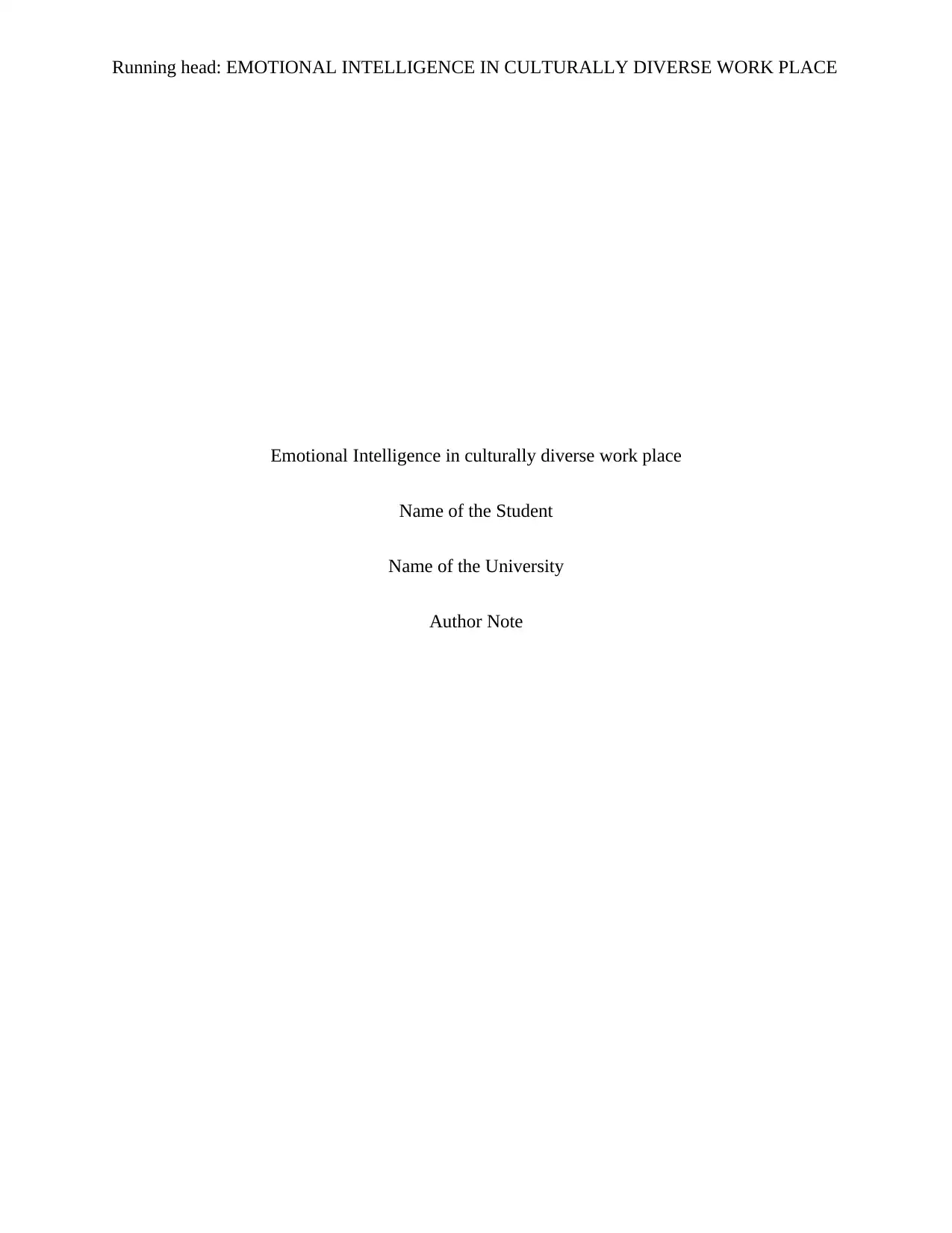
Running head: EMOTIONAL INTELLIGENCE IN CULTURALLY DIVERSE WORK PLACE
Emotional Intelligence in culturally diverse work place
Name of the Student
Name of the University
Author Note
Emotional Intelligence in culturally diverse work place
Name of the Student
Name of the University
Author Note
Paraphrase This Document
Need a fresh take? Get an instant paraphrase of this document with our AI Paraphraser
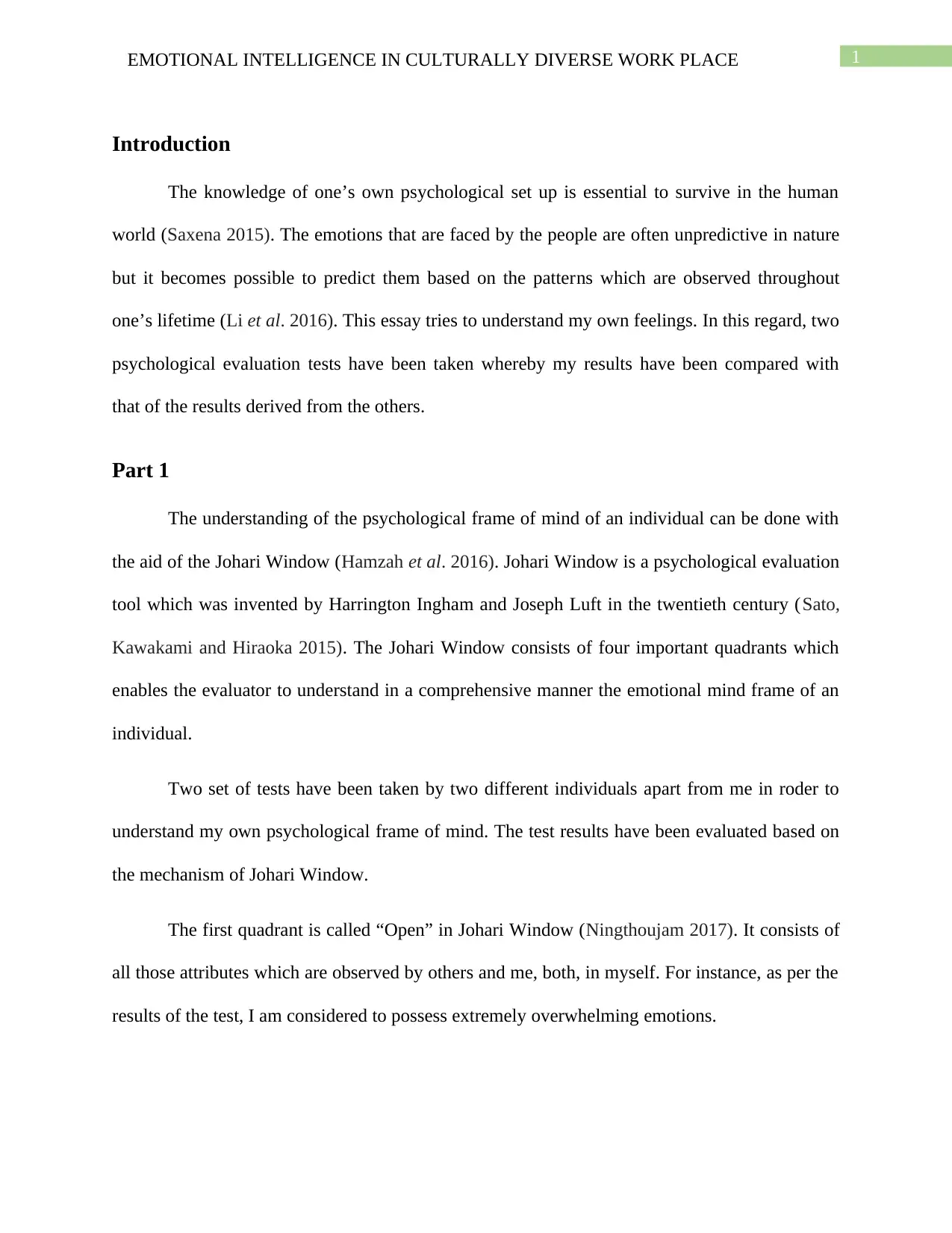
1EMOTIONAL INTELLIGENCE IN CULTURALLY DIVERSE WORK PLACE
Introduction
The knowledge of one’s own psychological set up is essential to survive in the human
world (Saxena 2015). The emotions that are faced by the people are often unpredictive in nature
but it becomes possible to predict them based on the patterns which are observed throughout
one’s lifetime (Li et al. 2016). This essay tries to understand my own feelings. In this regard, two
psychological evaluation tests have been taken whereby my results have been compared with
that of the results derived from the others.
Part 1
The understanding of the psychological frame of mind of an individual can be done with
the aid of the Johari Window (Hamzah et al. 2016). Johari Window is a psychological evaluation
tool which was invented by Harrington Ingham and Joseph Luft in the twentieth century (Sato,
Kawakami and Hiraoka 2015). The Johari Window consists of four important quadrants which
enables the evaluator to understand in a comprehensive manner the emotional mind frame of an
individual.
Two set of tests have been taken by two different individuals apart from me in roder to
understand my own psychological frame of mind. The test results have been evaluated based on
the mechanism of Johari Window.
The first quadrant is called “Open” in Johari Window (Ningthoujam 2017). It consists of
all those attributes which are observed by others and me, both, in myself. For instance, as per the
results of the test, I am considered to possess extremely overwhelming emotions.
Introduction
The knowledge of one’s own psychological set up is essential to survive in the human
world (Saxena 2015). The emotions that are faced by the people are often unpredictive in nature
but it becomes possible to predict them based on the patterns which are observed throughout
one’s lifetime (Li et al. 2016). This essay tries to understand my own feelings. In this regard, two
psychological evaluation tests have been taken whereby my results have been compared with
that of the results derived from the others.
Part 1
The understanding of the psychological frame of mind of an individual can be done with
the aid of the Johari Window (Hamzah et al. 2016). Johari Window is a psychological evaluation
tool which was invented by Harrington Ingham and Joseph Luft in the twentieth century (Sato,
Kawakami and Hiraoka 2015). The Johari Window consists of four important quadrants which
enables the evaluator to understand in a comprehensive manner the emotional mind frame of an
individual.
Two set of tests have been taken by two different individuals apart from me in roder to
understand my own psychological frame of mind. The test results have been evaluated based on
the mechanism of Johari Window.
The first quadrant is called “Open” in Johari Window (Ningthoujam 2017). It consists of
all those attributes which are observed by others and me, both, in myself. For instance, as per the
results of the test, I am considered to possess extremely overwhelming emotions.
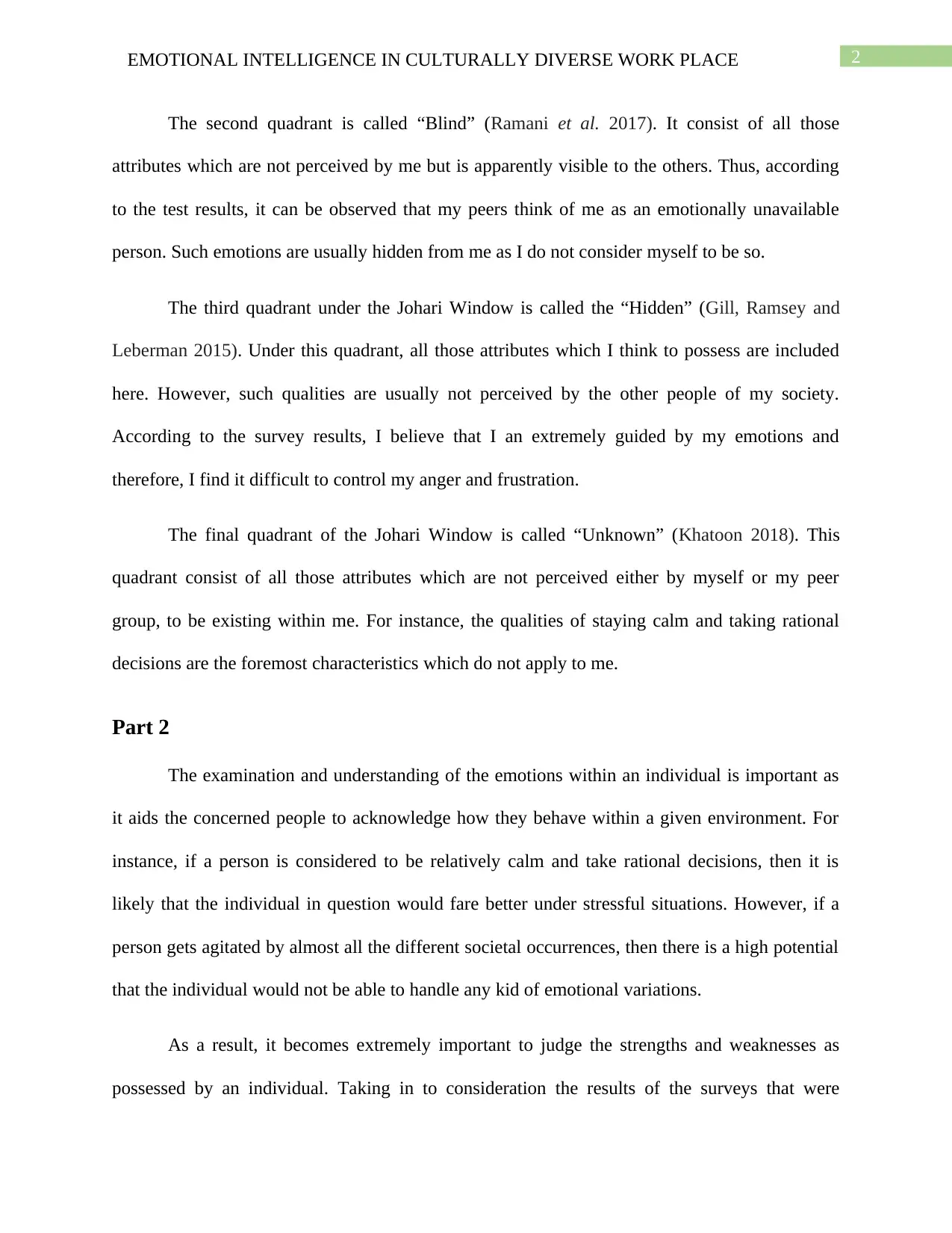
2EMOTIONAL INTELLIGENCE IN CULTURALLY DIVERSE WORK PLACE
The second quadrant is called “Blind” (Ramani et al. 2017). It consist of all those
attributes which are not perceived by me but is apparently visible to the others. Thus, according
to the test results, it can be observed that my peers think of me as an emotionally unavailable
person. Such emotions are usually hidden from me as I do not consider myself to be so.
The third quadrant under the Johari Window is called the “Hidden” (Gill, Ramsey and
Leberman 2015). Under this quadrant, all those attributes which I think to possess are included
here. However, such qualities are usually not perceived by the other people of my society.
According to the survey results, I believe that I an extremely guided by my emotions and
therefore, I find it difficult to control my anger and frustration.
The final quadrant of the Johari Window is called “Unknown” (Khatoon 2018). This
quadrant consist of all those attributes which are not perceived either by myself or my peer
group, to be existing within me. For instance, the qualities of staying calm and taking rational
decisions are the foremost characteristics which do not apply to me.
Part 2
The examination and understanding of the emotions within an individual is important as
it aids the concerned people to acknowledge how they behave within a given environment. For
instance, if a person is considered to be relatively calm and take rational decisions, then it is
likely that the individual in question would fare better under stressful situations. However, if a
person gets agitated by almost all the different societal occurrences, then there is a high potential
that the individual would not be able to handle any kid of emotional variations.
As a result, it becomes extremely important to judge the strengths and weaknesses as
possessed by an individual. Taking in to consideration the results of the surveys that were
The second quadrant is called “Blind” (Ramani et al. 2017). It consist of all those
attributes which are not perceived by me but is apparently visible to the others. Thus, according
to the test results, it can be observed that my peers think of me as an emotionally unavailable
person. Such emotions are usually hidden from me as I do not consider myself to be so.
The third quadrant under the Johari Window is called the “Hidden” (Gill, Ramsey and
Leberman 2015). Under this quadrant, all those attributes which I think to possess are included
here. However, such qualities are usually not perceived by the other people of my society.
According to the survey results, I believe that I an extremely guided by my emotions and
therefore, I find it difficult to control my anger and frustration.
The final quadrant of the Johari Window is called “Unknown” (Khatoon 2018). This
quadrant consist of all those attributes which are not perceived either by myself or my peer
group, to be existing within me. For instance, the qualities of staying calm and taking rational
decisions are the foremost characteristics which do not apply to me.
Part 2
The examination and understanding of the emotions within an individual is important as
it aids the concerned people to acknowledge how they behave within a given environment. For
instance, if a person is considered to be relatively calm and take rational decisions, then it is
likely that the individual in question would fare better under stressful situations. However, if a
person gets agitated by almost all the different societal occurrences, then there is a high potential
that the individual would not be able to handle any kid of emotional variations.
As a result, it becomes extremely important to judge the strengths and weaknesses as
possessed by an individual. Taking in to consideration the results of the surveys that were
⊘ This is a preview!⊘
Do you want full access?
Subscribe today to unlock all pages.

Trusted by 1+ million students worldwide
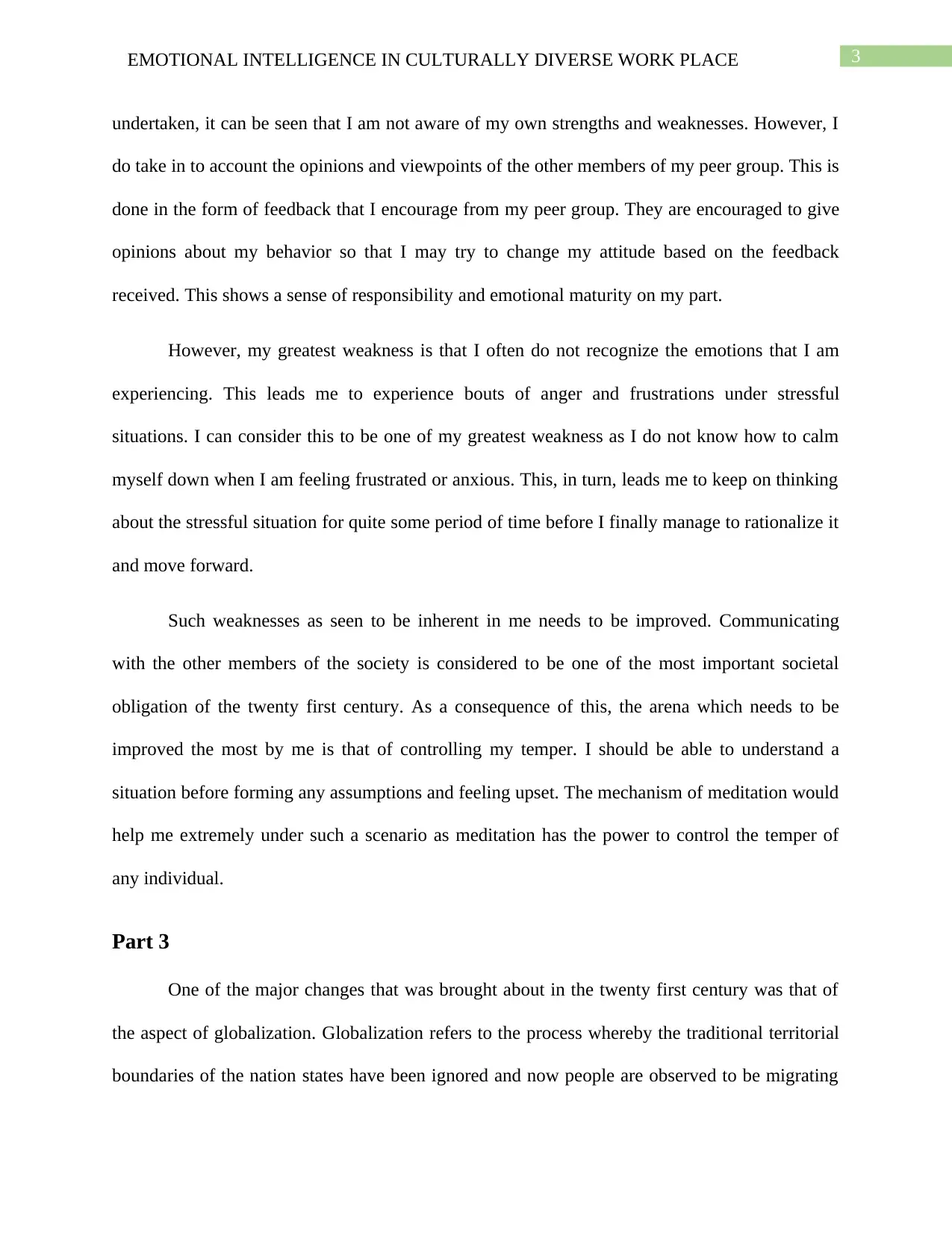
3EMOTIONAL INTELLIGENCE IN CULTURALLY DIVERSE WORK PLACE
undertaken, it can be seen that I am not aware of my own strengths and weaknesses. However, I
do take in to account the opinions and viewpoints of the other members of my peer group. This is
done in the form of feedback that I encourage from my peer group. They are encouraged to give
opinions about my behavior so that I may try to change my attitude based on the feedback
received. This shows a sense of responsibility and emotional maturity on my part.
However, my greatest weakness is that I often do not recognize the emotions that I am
experiencing. This leads me to experience bouts of anger and frustrations under stressful
situations. I can consider this to be one of my greatest weakness as I do not know how to calm
myself down when I am feeling frustrated or anxious. This, in turn, leads me to keep on thinking
about the stressful situation for quite some period of time before I finally manage to rationalize it
and move forward.
Such weaknesses as seen to be inherent in me needs to be improved. Communicating
with the other members of the society is considered to be one of the most important societal
obligation of the twenty first century. As a consequence of this, the arena which needs to be
improved the most by me is that of controlling my temper. I should be able to understand a
situation before forming any assumptions and feeling upset. The mechanism of meditation would
help me extremely under such a scenario as meditation has the power to control the temper of
any individual.
Part 3
One of the major changes that was brought about in the twenty first century was that of
the aspect of globalization. Globalization refers to the process whereby the traditional territorial
boundaries of the nation states have been ignored and now people are observed to be migrating
undertaken, it can be seen that I am not aware of my own strengths and weaknesses. However, I
do take in to account the opinions and viewpoints of the other members of my peer group. This is
done in the form of feedback that I encourage from my peer group. They are encouraged to give
opinions about my behavior so that I may try to change my attitude based on the feedback
received. This shows a sense of responsibility and emotional maturity on my part.
However, my greatest weakness is that I often do not recognize the emotions that I am
experiencing. This leads me to experience bouts of anger and frustrations under stressful
situations. I can consider this to be one of my greatest weakness as I do not know how to calm
myself down when I am feeling frustrated or anxious. This, in turn, leads me to keep on thinking
about the stressful situation for quite some period of time before I finally manage to rationalize it
and move forward.
Such weaknesses as seen to be inherent in me needs to be improved. Communicating
with the other members of the society is considered to be one of the most important societal
obligation of the twenty first century. As a consequence of this, the arena which needs to be
improved the most by me is that of controlling my temper. I should be able to understand a
situation before forming any assumptions and feeling upset. The mechanism of meditation would
help me extremely under such a scenario as meditation has the power to control the temper of
any individual.
Part 3
One of the major changes that was brought about in the twenty first century was that of
the aspect of globalization. Globalization refers to the process whereby the traditional territorial
boundaries of the nation states have been ignored and now people are observed to be migrating
Paraphrase This Document
Need a fresh take? Get an instant paraphrase of this document with our AI Paraphraser
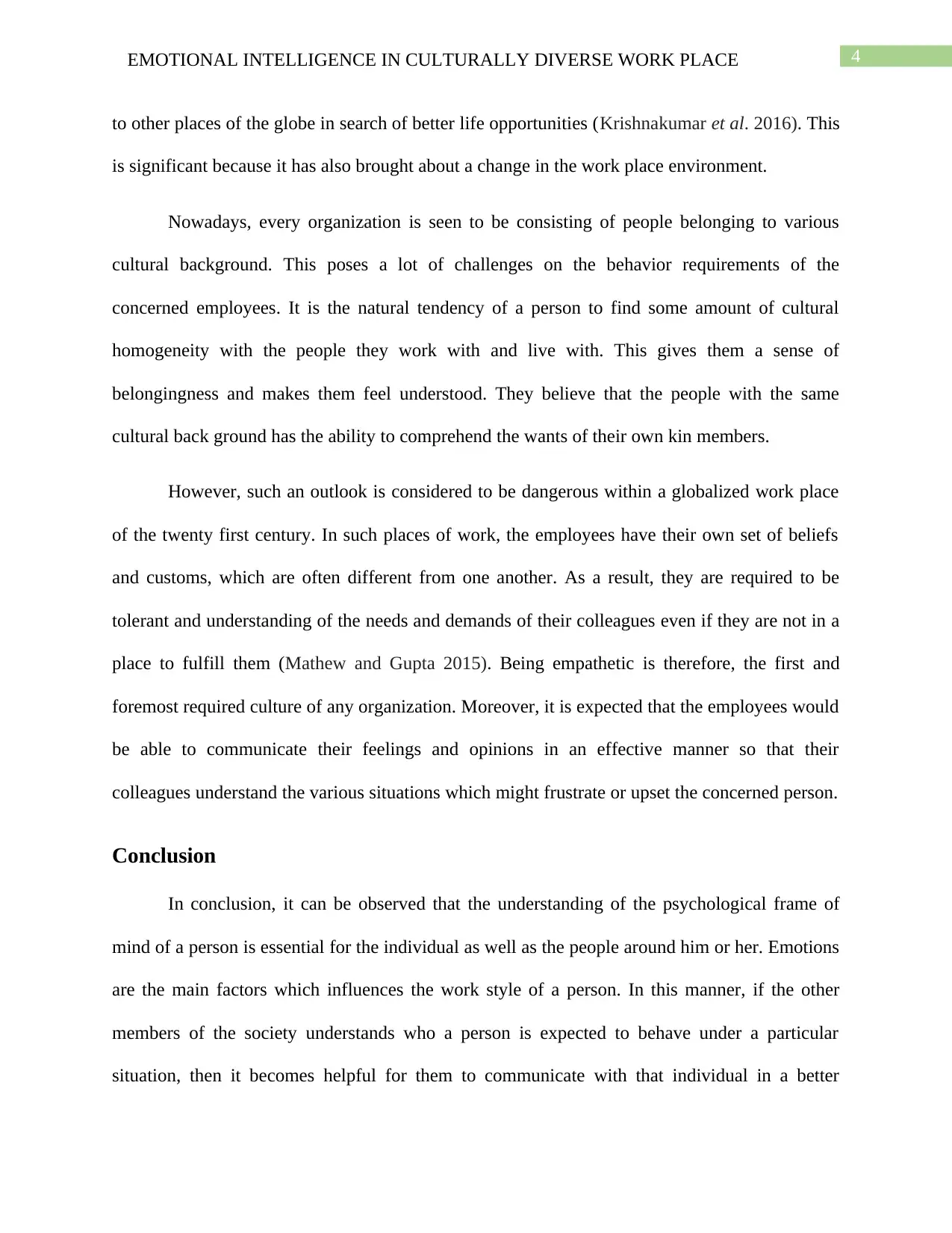
4EMOTIONAL INTELLIGENCE IN CULTURALLY DIVERSE WORK PLACE
to other places of the globe in search of better life opportunities (Krishnakumar et al. 2016). This
is significant because it has also brought about a change in the work place environment.
Nowadays, every organization is seen to be consisting of people belonging to various
cultural background. This poses a lot of challenges on the behavior requirements of the
concerned employees. It is the natural tendency of a person to find some amount of cultural
homogeneity with the people they work with and live with. This gives them a sense of
belongingness and makes them feel understood. They believe that the people with the same
cultural back ground has the ability to comprehend the wants of their own kin members.
However, such an outlook is considered to be dangerous within a globalized work place
of the twenty first century. In such places of work, the employees have their own set of beliefs
and customs, which are often different from one another. As a result, they are required to be
tolerant and understanding of the needs and demands of their colleagues even if they are not in a
place to fulfill them (Mathew and Gupta 2015). Being empathetic is therefore, the first and
foremost required culture of any organization. Moreover, it is expected that the employees would
be able to communicate their feelings and opinions in an effective manner so that their
colleagues understand the various situations which might frustrate or upset the concerned person.
Conclusion
In conclusion, it can be observed that the understanding of the psychological frame of
mind of a person is essential for the individual as well as the people around him or her. Emotions
are the main factors which influences the work style of a person. In this manner, if the other
members of the society understands who a person is expected to behave under a particular
situation, then it becomes helpful for them to communicate with that individual in a better
to other places of the globe in search of better life opportunities (Krishnakumar et al. 2016). This
is significant because it has also brought about a change in the work place environment.
Nowadays, every organization is seen to be consisting of people belonging to various
cultural background. This poses a lot of challenges on the behavior requirements of the
concerned employees. It is the natural tendency of a person to find some amount of cultural
homogeneity with the people they work with and live with. This gives them a sense of
belongingness and makes them feel understood. They believe that the people with the same
cultural back ground has the ability to comprehend the wants of their own kin members.
However, such an outlook is considered to be dangerous within a globalized work place
of the twenty first century. In such places of work, the employees have their own set of beliefs
and customs, which are often different from one another. As a result, they are required to be
tolerant and understanding of the needs and demands of their colleagues even if they are not in a
place to fulfill them (Mathew and Gupta 2015). Being empathetic is therefore, the first and
foremost required culture of any organization. Moreover, it is expected that the employees would
be able to communicate their feelings and opinions in an effective manner so that their
colleagues understand the various situations which might frustrate or upset the concerned person.
Conclusion
In conclusion, it can be observed that the understanding of the psychological frame of
mind of a person is essential for the individual as well as the people around him or her. Emotions
are the main factors which influences the work style of a person. In this manner, if the other
members of the society understands who a person is expected to behave under a particular
situation, then it becomes helpful for them to communicate with that individual in a better
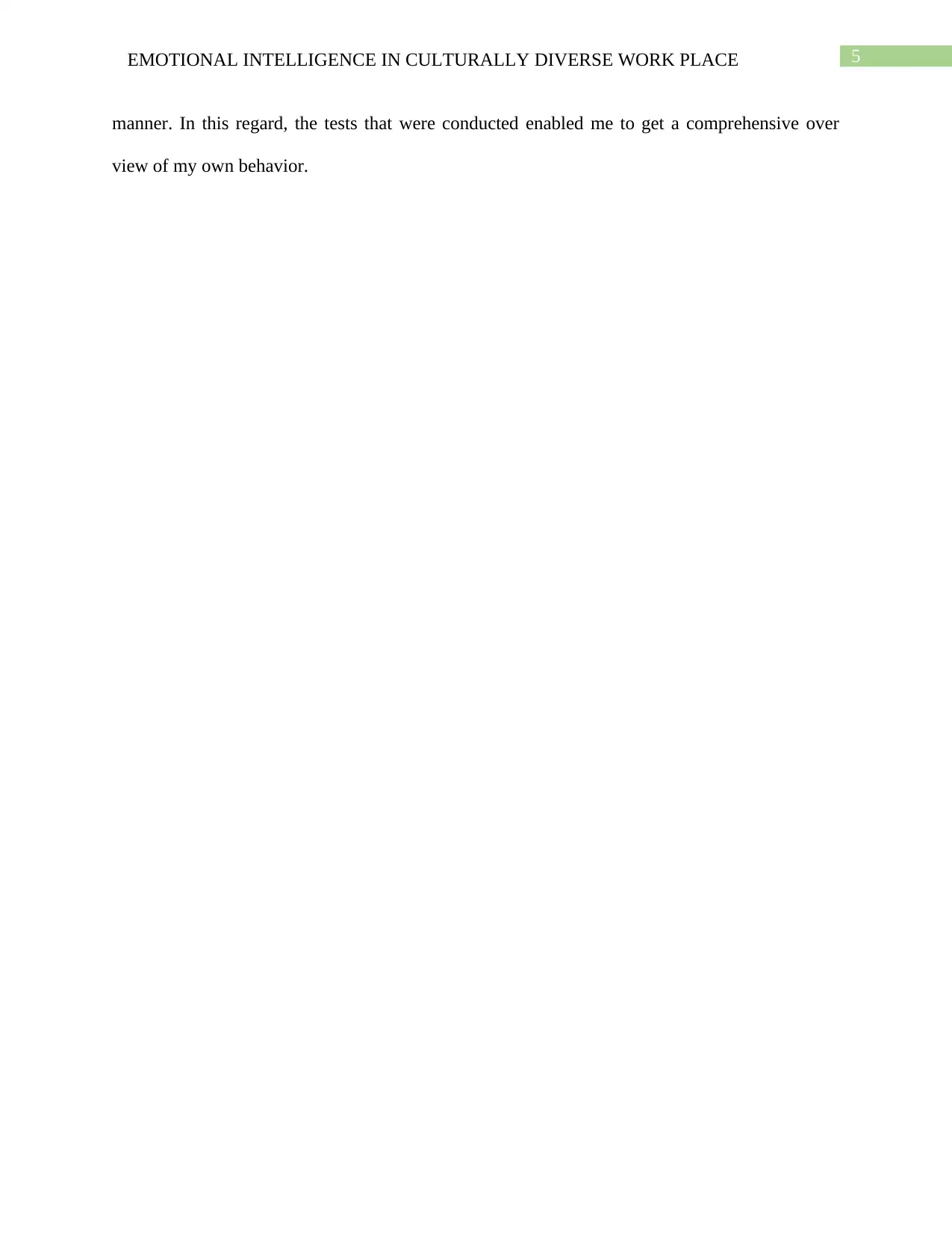
5EMOTIONAL INTELLIGENCE IN CULTURALLY DIVERSE WORK PLACE
manner. In this regard, the tests that were conducted enabled me to get a comprehensive over
view of my own behavior.
manner. In this regard, the tests that were conducted enabled me to get a comprehensive over
view of my own behavior.
⊘ This is a preview!⊘
Do you want full access?
Subscribe today to unlock all pages.

Trusted by 1+ million students worldwide
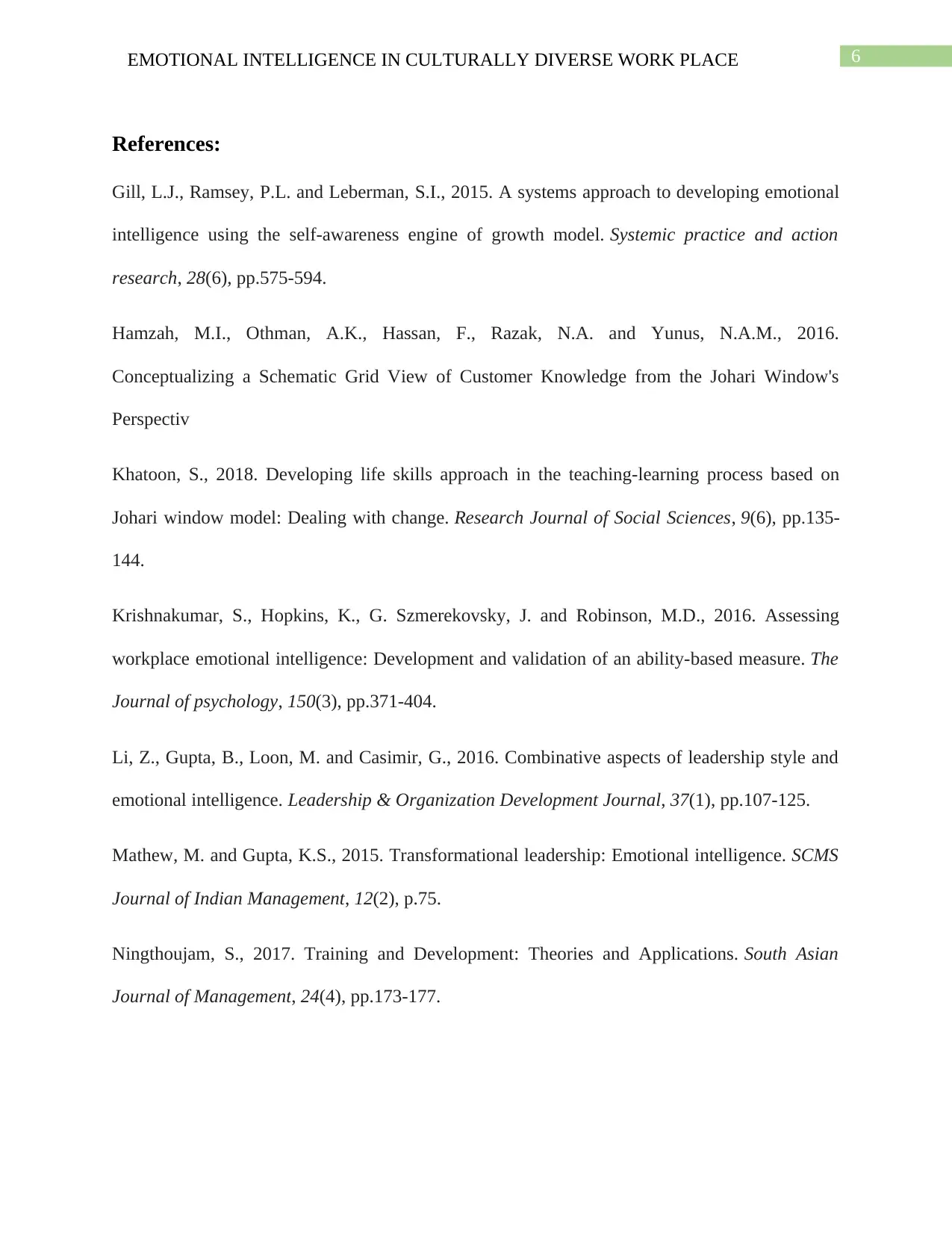
6EMOTIONAL INTELLIGENCE IN CULTURALLY DIVERSE WORK PLACE
References:
Gill, L.J., Ramsey, P.L. and Leberman, S.I., 2015. A systems approach to developing emotional
intelligence using the self-awareness engine of growth model. Systemic practice and action
research, 28(6), pp.575-594.
Hamzah, M.I., Othman, A.K., Hassan, F., Razak, N.A. and Yunus, N.A.M., 2016.
Conceptualizing a Schematic Grid View of Customer Knowledge from the Johari Window's
Perspectiv
Khatoon, S., 2018. Developing life skills approach in the teaching-learning process based on
Johari window model: Dealing with change. Research Journal of Social Sciences, 9(6), pp.135-
144.
Krishnakumar, S., Hopkins, K., G. Szmerekovsky, J. and Robinson, M.D., 2016. Assessing
workplace emotional intelligence: Development and validation of an ability-based measure. The
Journal of psychology, 150(3), pp.371-404.
Li, Z., Gupta, B., Loon, M. and Casimir, G., 2016. Combinative aspects of leadership style and
emotional intelligence. Leadership & Organization Development Journal, 37(1), pp.107-125.
Mathew, M. and Gupta, K.S., 2015. Transformational leadership: Emotional intelligence. SCMS
Journal of Indian Management, 12(2), p.75.
Ningthoujam, S., 2017. Training and Development: Theories and Applications. South Asian
Journal of Management, 24(4), pp.173-177.
References:
Gill, L.J., Ramsey, P.L. and Leberman, S.I., 2015. A systems approach to developing emotional
intelligence using the self-awareness engine of growth model. Systemic practice and action
research, 28(6), pp.575-594.
Hamzah, M.I., Othman, A.K., Hassan, F., Razak, N.A. and Yunus, N.A.M., 2016.
Conceptualizing a Schematic Grid View of Customer Knowledge from the Johari Window's
Perspectiv
Khatoon, S., 2018. Developing life skills approach in the teaching-learning process based on
Johari window model: Dealing with change. Research Journal of Social Sciences, 9(6), pp.135-
144.
Krishnakumar, S., Hopkins, K., G. Szmerekovsky, J. and Robinson, M.D., 2016. Assessing
workplace emotional intelligence: Development and validation of an ability-based measure. The
Journal of psychology, 150(3), pp.371-404.
Li, Z., Gupta, B., Loon, M. and Casimir, G., 2016. Combinative aspects of leadership style and
emotional intelligence. Leadership & Organization Development Journal, 37(1), pp.107-125.
Mathew, M. and Gupta, K.S., 2015. Transformational leadership: Emotional intelligence. SCMS
Journal of Indian Management, 12(2), p.75.
Ningthoujam, S., 2017. Training and Development: Theories and Applications. South Asian
Journal of Management, 24(4), pp.173-177.
Paraphrase This Document
Need a fresh take? Get an instant paraphrase of this document with our AI Paraphraser
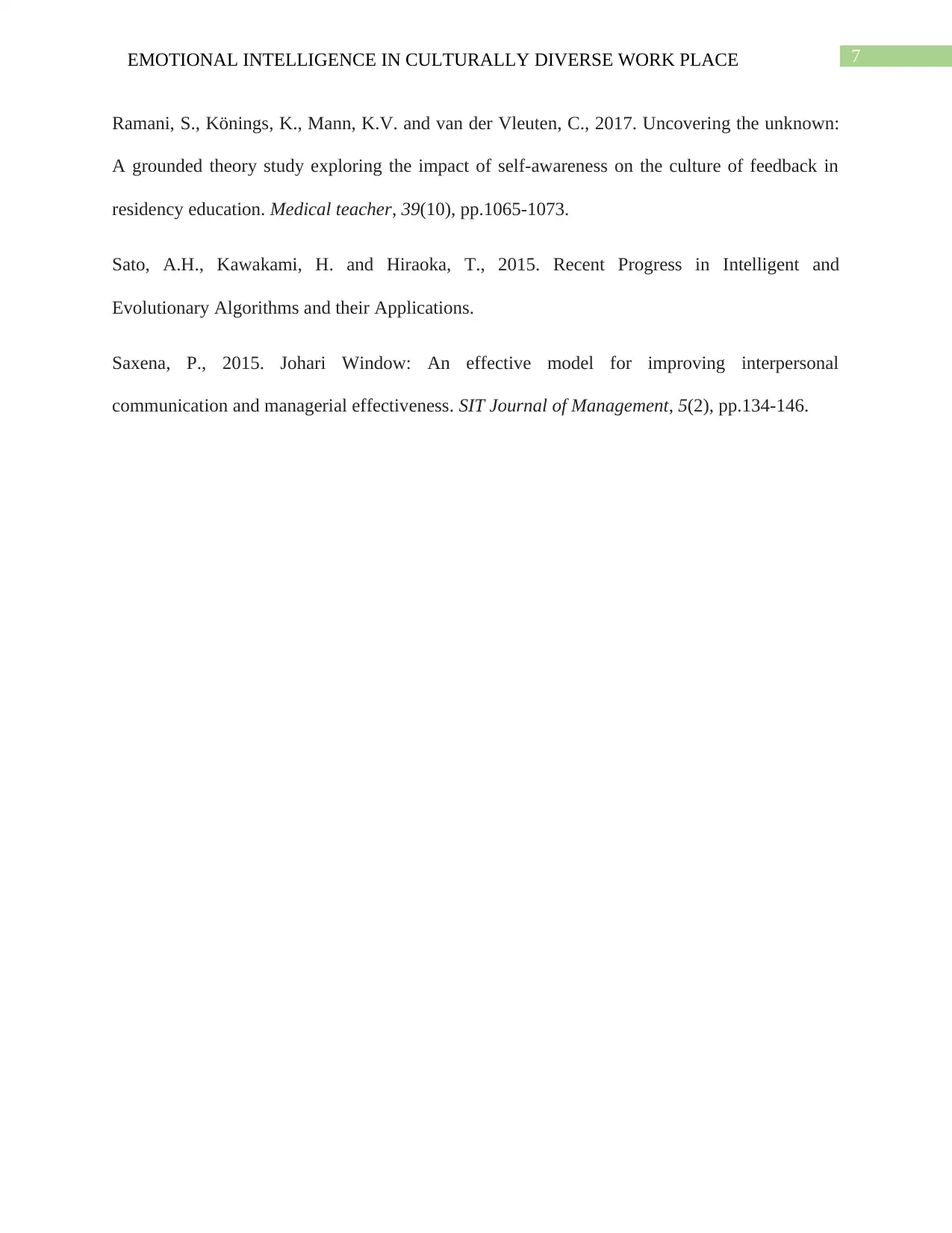
7EMOTIONAL INTELLIGENCE IN CULTURALLY DIVERSE WORK PLACE
Ramani, S., Könings, K., Mann, K.V. and van der Vleuten, C., 2017. Uncovering the unknown:
A grounded theory study exploring the impact of self-awareness on the culture of feedback in
residency education. Medical teacher, 39(10), pp.1065-1073.
Sato, A.H., Kawakami, H. and Hiraoka, T., 2015. Recent Progress in Intelligent and
Evolutionary Algorithms and their Applications.
Saxena, P., 2015. Johari Window: An effective model for improving interpersonal
communication and managerial effectiveness. SIT Journal of Management, 5(2), pp.134-146.
Ramani, S., Könings, K., Mann, K.V. and van der Vleuten, C., 2017. Uncovering the unknown:
A grounded theory study exploring the impact of self-awareness on the culture of feedback in
residency education. Medical teacher, 39(10), pp.1065-1073.
Sato, A.H., Kawakami, H. and Hiraoka, T., 2015. Recent Progress in Intelligent and
Evolutionary Algorithms and their Applications.
Saxena, P., 2015. Johari Window: An effective model for improving interpersonal
communication and managerial effectiveness. SIT Journal of Management, 5(2), pp.134-146.
1 out of 8
Related Documents
Your All-in-One AI-Powered Toolkit for Academic Success.
+13062052269
info@desklib.com
Available 24*7 on WhatsApp / Email
![[object Object]](/_next/static/media/star-bottom.7253800d.svg)
Unlock your academic potential
Copyright © 2020–2025 A2Z Services. All Rights Reserved. Developed and managed by ZUCOL.





